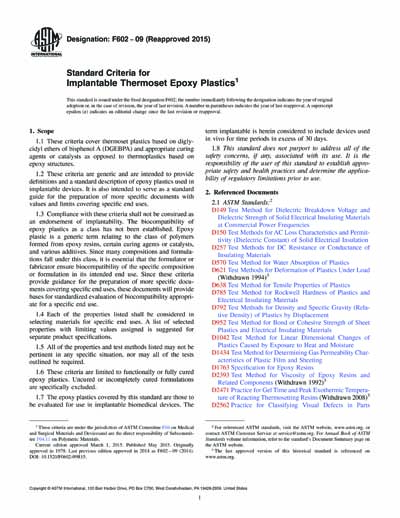Most recent
ASTM F602-09(2015)
Standard Criteria for Implantable Thermoset Epoxy Plastics
1.1 These criteria cover thermoset plastics based on diglycidyl ethers of bisphenol A (DGEBPA) and appropriate curing agents or catalysts as opposed to thermoplastics based on epoxy structures.
1.2 These criteria are generic and are intended to provide definitions and a standard description of epoxy plastics used in implantable devices. It is also intended to serve as a standard guide for the preparation of more specific documents with values and limits covering specific end uses.
1.3 Compliance with these criteria shall not be construed as an endorsement of implantability. The biocompatibility of epoxy plastics as a class has not been established. Epoxy plastic is a generic term relating to the class of polymers formed from epoxy resins, certain curing agents or catalysts, and various additives. Since many compositions and formulations fall under this class, it is essential that the formulator or fabricator ensure biocompatibility of the specific composition or formulation in its intended end use. Since these criteria provide guidance for the preparation of more specific documents covering specific end uses, these documents will provide bases for standardized evaluation of biocompatibility appropriate for a specific end use.
1.4 Each of the properties listed shall be considered in selecting materials for specific end uses. A list of selected properties with limiting values assigned is suggested for separate product specifications.
1.5 All of the properties and test methods listed may not be pertinent in any specific situation, nor may all of the tests outlined be required.
1.6 These criteria are limited to functionally or fully cured epoxy plastics. Uncured or incompletely cured formulations are specifically excluded.
1.7 The epoxy plastics covered by this standard are those to be evaluated for use in implantable biomedical devices. The term implantable is herein considered to include devices used in vivo for time periods in excess of 30 days.
1.8 This standard does not purport to address all of the safety concerns, if any, associated with its use. It is the responsibility of the user of this standard to establish appropriate safety and health practices and determine the applicability of regulatory limitations prior to use.
Content Provider
ASTM International [astm]






